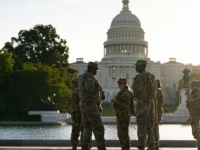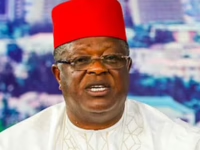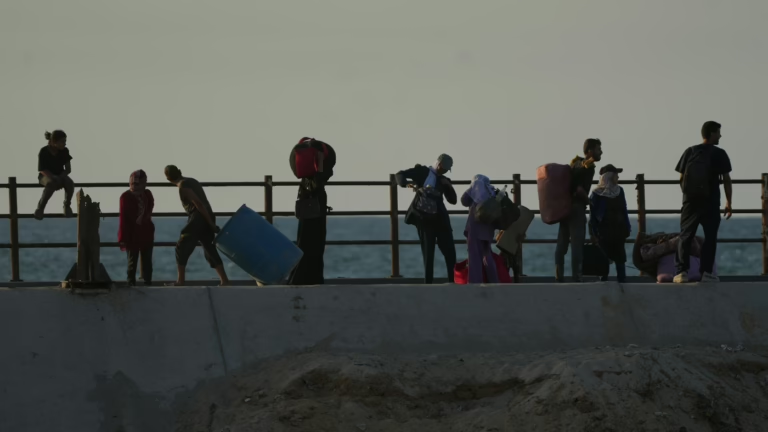Palestinians displaced from northern Gaza move along the coastal road near Wadi Gaza, Thursday, Oct. 2, 2025.
Abdel Kareem Hana/AP
toggle caption
Abdel Kareem Hana/AP
DEIR AL-BALAH, Gaza Strip – On Friday, Hamas announced its conditional acceptance of certain components of U.S. President Donald Trump’s proposal aimed at resolving the ongoing conflict in Gaza. The group agreed to relinquish control and free all remaining hostages but indicated that other parts of the plan require further dialogue among Palestinian factions.
This declaration followed President Trump’s ultimatum that Hamas must consent to the agreement by Sunday evening, warning of an intensified military campaign if they fail to comply. The response from the U.S. and Israel to Hamas’s partial acceptance remains uncertain.
Hamas expressed readiness to release hostages in line with the plan’s outlined “formula,” which likely involves the liberation of Palestinian detainees. The group also reaffirmed its willingness to transfer authority to a politically neutral Palestinian entity.
However, Hamas emphasized that decisions regarding Gaza’s future and Palestinian rights should be made through a “unanimous Palestinian consensus” involving other factions and grounded in international law.
Notably, the statement omitted any reference to disarmament, a critical Israeli condition embedded in Trump’s proposal.
Trump’s Proposal: Ceasefire and Hostage Release
President Trump is eager to fulfill his promise of ending the conflict and securing the release of numerous hostages ahead of the war’s second anniversary on Tuesday. While Israel has accepted the peace plan and it has garnered international support, key mediators such as Egypt and Qatar have indicated that some aspects require further negotiation, without providing specifics.
“An agreement must be finalized with Hamas by Sunday at 6 P.M. Washington, D.C. time,” Trump declared on social media Friday. “Every nation has endorsed it! If this final opportunity is missed, unprecedented devastation will be unleashed on Hamas. Peace in the Middle East will be achieved one way or another.”
The plan, unveiled earlier this week alongside Israeli Prime Minister Benjamin Netanyahu, calls for Hamas to immediately free the remaining 48 hostages-approximately 20 of whom are believed to be alive-cede control, and disarm.
In exchange, Israel would cease its military operations, withdraw from significant portions of Gaza, release hundreds of Palestinian prisoners, and permit a surge of humanitarian aid and reconstruction efforts. Proposals to relocate much of Gaza’s population abroad would be abandoned.
Governance of the roughly two million residents in Gaza would transition to an international administration overseen by Trump and former British Prime Minister Tony Blair. The plan does not outline a route for Gaza’s reunification with the Israeli-occupied West Bank in a future Palestinian state.
A Hamas official recently told The Associated Press that certain elements of the plan are unacceptable and require revision, without providing further details. While Palestinians yearn for an end to the conflict, many perceive this and previous U.S. initiatives as heavily favoring Israel.
Heightened Pressure from U.S. and Israel
Since terminating a ceasefire in March, Israel has intensified its campaign against Hamas, imposing a blockade that has cut off food, medicine, and essential supplies for over two months. Large swaths of Gaza have been seized, demolished, and largely emptied of residents.
Experts concluded that Gaza City was on the brink of famine just before Israel launched a major offensive aimed at occupying the area. In recent weeks, approximately 400,000 people have fled the city, though hundreds of thousands remain.
Olga Cherevko, spokesperson for the U.N. humanitarian office, recounted seeing displaced families sheltering in the parking lot of Shifa Hospital during a visit on Thursday.
“They cannot move south because they lack the means,” Cherevko told The Associated Press. “One family had three children, and the mother was pregnant with her fourth. There were many vulnerable individuals, including elderly and disabled people.”
Trump asserted that most Hamas fighters are “encircled and militarily trapped, awaiting my command to be swiftly eliminated. As for the rest, we know their identities and locations-they will be pursued and neutralized.”
Although many of Hamas’s senior leaders and thousands of fighters have been killed, the group retains influence in areas outside Israeli military control and continues to launch sporadic attacks that have caused Israeli casualties.
Hamas maintains that it will only free the remaining hostages-its key leverage and potential human shields-in exchange for a durable ceasefire and Israeli withdrawal. Netanyahu has dismissed these conditions, insisting that Hamas must surrender and disarm.
Approaching the Conflict’s Second Anniversary
On October 7, 2023, thousands of Hamas militants launched a surprise assault into Israel, targeting military bases, agricultural communities, and an outdoor music festival, resulting in approximately 1,200 deaths, predominantly civilians. They abducted 251 individuals, most of whom have since been released through ceasefires or negotiations.
Israel’s retaliatory campaign has claimed over 66,000 Palestinian lives, according to Gaza’s Health Ministry, which does not specify the breakdown between civilians and combatants. Women and children reportedly constitute about half of the fatalities.
The Health Ministry, operated by the Hamas government, is regarded by the U.N. and many independent analysts as the most credible source for wartime casualty figures.
The conflict has displaced nearly 90% of Gaza’s population, often multiple times, rendering much of the territory uninhabitable.
Both the Biden and Trump administrations have endeavored to halt hostilities and secure the hostages’ release while continuing to provide substantial military and diplomatic backing to Israel.






















